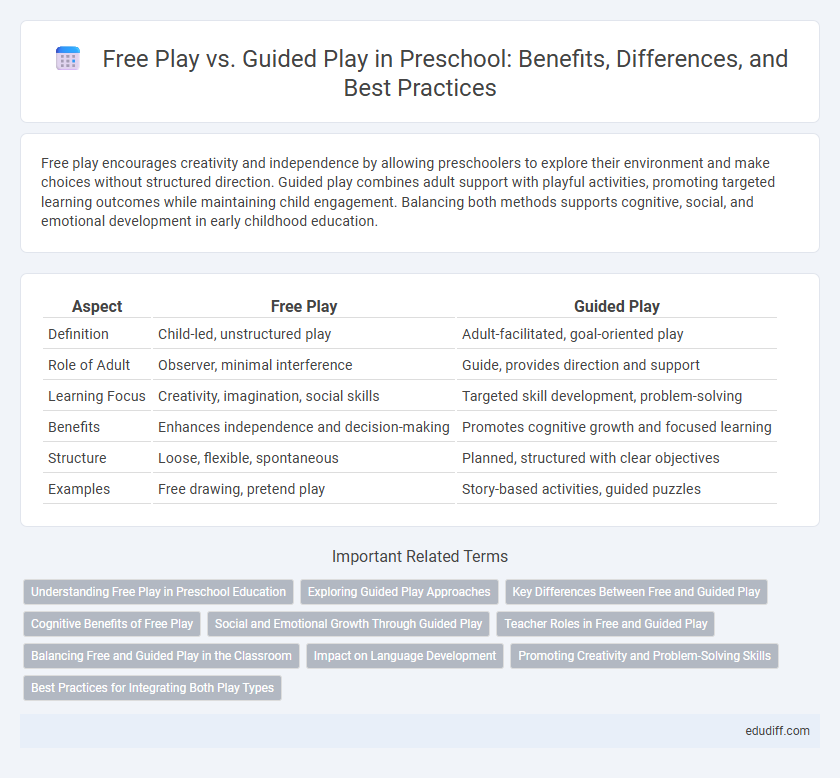Free play encourages creativity and independence by allowing preschoolers to explore their environment and make choices without structured direction. Guided play combines adult support with playful activities, promoting targeted learning outcomes while maintaining child engagement. Balancing both methods supports cognitive, social, and emotional development in early childhood education.
Table of Comparison
| Aspect | Free Play | Guided Play |
|---|---|---|
| Definition | Child-led, unstructured play | Adult-facilitated, goal-oriented play |
| Role of Adult | Observer, minimal interference | Guide, provides direction and support |
| Learning Focus | Creativity, imagination, social skills | Targeted skill development, problem-solving |
| Benefits | Enhances independence and decision-making | Promotes cognitive growth and focused learning |
| Structure | Loose, flexible, spontaneous | Planned, structured with clear objectives |
| Examples | Free drawing, pretend play | Story-based activities, guided puzzles |
Understanding Free Play in Preschool Education
Free play in preschool education fosters creativity, problem-solving, and social skills by allowing children to explore their interests without direct adult intervention. This unstructured environment supports cognitive development and emotional regulation through imaginative activities and spontaneous interactions. Research shows that free play enhances executive functioning and promotes self-directed learning, which are critical for early childhood development.
Exploring Guided Play Approaches
Guided play blends child-led exploration with intentional adult support, fostering deeper learning outcomes in preschool settings. Educators strategically scaffold activities to promote cognitive, social, and emotional development while maintaining play's intrinsic motivation. Research shows guided play enhances language acquisition, problem-solving skills, and executive function more effectively than free play alone.
Key Differences Between Free and Guided Play
Free play allows preschool children to explore their interests independently, fostering creativity and decision-making skills without adult intervention. Guided play involves intentional adult support where educators structure activities to target specific learning outcomes while maintaining child-led engagement. The key difference lies in the balance of autonomy and direction, with free play emphasizing self-guided discovery and guided play combining exploration with purposeful guidance.
Cognitive Benefits of Free Play
Free play in preschool fosters cognitive development by promoting creativity, problem-solving skills, and executive function through unstructured exploration. Children engage in self-directed activities that enhance brain plasticity and encourage independent thinking. Research shows that free play supports memory retention and attention span better than highly structured guided play.
Social and Emotional Growth Through Guided Play
Guided play in preschool settings significantly enhances social and emotional growth by fostering cooperative interactions and emotional regulation among children. Structured activities led by educators encourage empathy, turn-taking, and problem-solving, which are critical for developing self-awareness and interpersonal skills. This targeted engagement promotes a supportive environment where children feel secure to express emotions and build positive relationships.
Teacher Roles in Free and Guided Play
Teacher roles in free play center on observation and creating a safe, stimulating environment that encourages children's independence and creativity. In guided play, teachers actively facilitate learning by introducing targeted questions, materials, and prompts that align with educational goals while maintaining playful engagement. Effective educators balance both approaches to support social, cognitive, and emotional development in preschool settings.
Balancing Free and Guided Play in the Classroom
Balancing free play and guided play in the preschool classroom enhances cognitive, social, and emotional development by providing children opportunities to explore independently while receiving structured support from educators. Research shows that free play fosters creativity and decision-making, whereas guided play aligns activities with learning goals and reinforces specific skills. Educators should strategically integrate both play types to create a dynamic learning environment that nurtures autonomy and targeted skill acquisition.
Impact on Language Development
Free play promotes spontaneous language use, enhancing vocabulary acquisition and conversational skills through natural interactions. Guided play provides structured opportunities for targeted language development, reinforcing specific vocabulary and grammar concepts. Combining both approaches maximizes language growth by balancing creativity with focused learning in preschool settings.
Promoting Creativity and Problem-Solving Skills
Free play in preschool environments fosters creativity and problem-solving skills by allowing children to explore their interests independently, encouraging imaginative thinking and self-directed discovery. Guided play balances adult facilitation with child-led exploration, introducing targeted challenges and prompts that stimulate critical thinking while maintaining a playful context. Both approaches complement each other by nurturing cognitive flexibility and innovative problem-solving essential for early childhood development.
Best Practices for Integrating Both Play Types
Incorporating both free play and guided play in preschool settings enhances cognitive and social development by balancing child-led exploration with adult-facilitated learning objectives. Best practices involve creating structured play environments where educators observe and gently scaffold activities, encouraging creativity while reinforcing essential skills such as language, problem-solving, and cooperation. Optimizing this integration requires flexible scheduling, diverse materials, and ongoing assessment to adapt play strategies that meet individual developmental needs and promote holistic growth.
Free play vs Guided play Infographic

 edudiff.com
edudiff.com